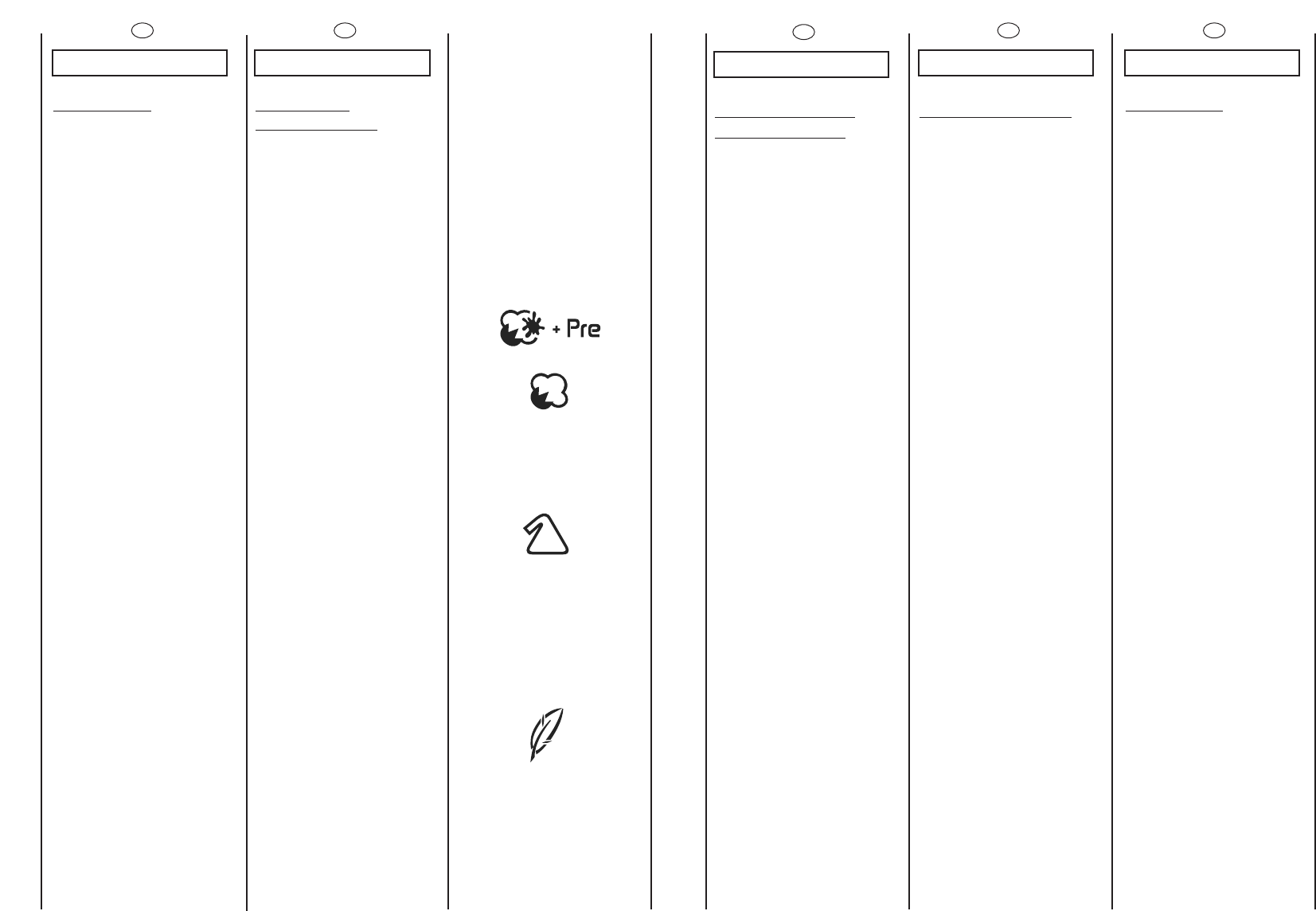
54
EN
55
CHAPTER 8
SELECTION
For the various types of
fabrics and various degrees
of dirt the washing machine
has 4 different programme
bands according to: wash
cycle,temperature and
lenght of cycle (see table of
washing cycle
programmes).
1 RESISTANTS FABRICS
The programmes have been
designed for a maximum
wash and the rinses,with
spin intervals,ensure perfect
rinsing.
The final spin gives more
efficient removal of water.
2 MIXED AND SYNTHETIC
FABRICS
The main wash and the rinse
gives best results thanks to
the rotation rhythms of the
drum and to the water
levels.
A gentle spin will mean that
the fabrics become less
creased.
3 SPECIAL DELICATE FIBRES
This is a new wash cycle
which alternates washing
and soaking and is
particularly recommended
for very delicate fabrics.
The wash cycle and rinses
are carried out with high
water levels to ensure best
results.
FR
CHAPITRE 8
SELECTION
L’appareil dispose de 4
groupes de programmes
différents pour laver tous
types de tissus et selon
différents degrés de salissure
en attribuant au type de
lavage,la température et la
durée (voir tableau des
programmes de lavage).
1. TISSUS RÉSISTANTS
Ces programmes sont
destinés à accomplir des
lavages et des rinçages avec
le maximum d’efficacité.
Ils sont entrecoupés de cycles
d’essorages qui offrent des
résultats parfaits sur le
rinçage.
L’essorage final retire le
maximum d’eau contenue
dans les tissus.
2. TISSUS MIXTES ET
SYNTHÉTIQUES
La combinaison d’un système
de lavage efficace,une
rotation optimum du tambour
et l’autogestion du niveau
d’eau assurent des résultats
de lavage excellents,
pendant qu’un rinçage
délicat évite les faux plis.
3. TISSUS TRÈS DÉLICATS
Il s’agit d’un nouveau
concept de lavage qui
alterne des moments de
brassage et de trempage du
linge; ce processus est
particulièrement indiqué pour
le lavage de tissus
extrêmement délicats.
Le lavage et le rinçage sont
effectués à pleine eau afin
d’obtenir les meilleures
prestations.
IT
CAPITOLO 8
SELEZIONE
PROGRAMMI
Per trattare i vari tipi di
tessuto e le varie gradazioni
di sporco,la lavatrice ha 4
fasce di programmi diversi
per tipo di tessuto,
temperatura e durata
(vedere tabella programmi
di lavaggio).
1. TESSUTI RESISTENTI
I programmi sono realizzati
per sviluppare il massimo
grado di lavaggio e i
risciacqui,intervallati da fasi
di centrifuga,assicurano un
perfetto risciacquo.
La centrifuga finale alla
massima velocità assicura
un’ottima strizzatura.
2. TESSUTI MISTI E SINTETICI
Il lavaggio ed il risciacquo
sono ottimizzati nei ritmi di
rotazione del cesto e nei
livelli di acqua.
La centrifuga ad azione
delicata,assicura una
ridotta formazione di pieghe
sui tessuti.
3. TESSUTI DELICATISSIMI
E’un nuovo concetto di
lavaggio in quanto alterna
momenti di lavoro a
momenti di pausa,
particolarmente indicato
per il lavaggio di tessuti
molto delicati.Il lavaggio e i
risciacqui sono eseguiti con
alto livello di acqua per
assicurare le migliori
prestazioni.
NL
HOOFDSTUK 8
KIEZEN VAN HET
PROGRAMMA
Voor de verschillende soorten
weefsels en afhankelijk van
de graad van vervuiling van
het wasgoed heeft de
wasautomaat 4 verschillende
hoofdgroepen: (zie het
overzicht van de
wasprogramma’s).
1. STERKE WEEFSELS
Deze programma’s zijn
bestemd om grondig te
wassen.De verschillende
spoelgangen,die tussendoor
gecentrifugeerd worden,
zorgen dat er perfect
gespoeld wordt.Bij de laatste
centrifugegang wordt het
water optimaal verwijderd.
2. GEMENGDE EN
SYNTHETISCHE WEEFSELS
Dankzij een speciale
trommelbeweging en het
hogere waterniveau wordt er
tijdens de hoofdwas en de
spoeling de beste resultaten
behaald.Er wordt met een
laag toerental
gecentrifugeerd om kreuken
te voorkomen.
3. BIJZONDER GEVOELIGE
WEEFSELS
Dit is een nieuw wasconcept,
met een cyclus die bestaat uit
elkaar opvolgende periodes
van activiteit en pauzes,
vooral geschikt voor het
wassen van uiterst fijne stoffen.
Wassen en spoelen gebeuren
met hoge waterniveaus voor
het beste wasresultaat.
RU
ÏÀPÀÃPÀÔ 8
ÇõÅéê èêéÉêÄåå
Ä∧ÿ paç∧è÷íûx òèïoâ òêaíeé è
còeïeíè çaãpÿçíeíèÿ ∋òa
còèpa∧üíaÿ ìaøèía èìeeò 4
ãpyïïû ïpoãpaìì, â
cooòâeòcòâèè c êoòopûìè
âûáèpaeò öèê∧còèpêè,
òeìïepaòypy è
ïpoäo∧æèòe∧üíocòü còèpêè
(cì. òaá∧èöy ïpoãpaìì
còèpêè).
1. èêéóçõÖ íäÄçà
∋òoò ̇·Ó ïpoãpaìì
paçpaáoòaí ä∧ÿ ìaêcèìa∧üío
èíòeícèâoé còèpêè è
ïo∧ocêaíèÿ c
ïpoìeæyòo÷íûìè öèê∧aìè
oòæèìa ä∧ÿ íaè∧y÷øeão
êa÷ecòâa ïo∧ocêaíèÿ.
Çaê∧ю÷èòe∧üíûé oòæèì
yäa∧ÿeò âoäy áo∧ee
èíòeícèâío, ÷eì äpyòèe
ïpoãpaììû còèpêè.
2. ëåÖëéÇõÖ à ëàçíÖíàóÖëäàÖ
íäÄçà
Ocíoâíaÿ còèpêa è ïo∧ocêaíèe
äaюò oò∧è÷íûe peçy∧üòaòû
á∧aãoäapÿ òùaòe∧üío
ïoäoápaííoé cêopocòè
âpaùeíèÿ áapaáaía è ÛÓ‚Ìfl
âoäû. Äe∧èêaòíûé oòæèì
ãapaíòèpyeò, ÷òo áe∧üe áyäeò
ìeíüøe cìèíaòücÿ.
3. íäÄçà, óìÇëíÇàíÖãúçõÖ ä
ÇçÖòçÖåì ÇéáÑÖâëíÇàû
ëÚË͇ ˜Â‰ÛÂÚÒfl Ò
ÔÓ‰ÓÎÊËÚÂθÌ˚ÏË Ô‡ÛÁ‡ÏË.
êÂÍÓÏẨÛÂÚÒfl ‰Îfl Ú͇ÌÂÈ,
˜Û‚ÒÚ‚ËÚÂθÌ˚ı Í ‡Á΢Ì˚Ï ‚ˉ‡Ï
‚̯ÌÂ„Ó ‚ÓÁ‰ÂÈÒÚ‚Ëfl.
óÚÓ·˚ ‚ÓÁ‰ÂÈÒÚ‚Ë ̇ Ú̸͇ ·˚ÎÓ
˘‡‰fl˘ËÏ, ‚Ó‰˚ ‰Îfl ÒÚËÍË Ë
ÔÓÎÓÒ͇ÌËfl ·ÂÂÚÒfl ·Óθ¯Â, ˜ÂÏ ‚
ÓÒڇθÌ˚ı ÔÓ„‡Ïχı.


















